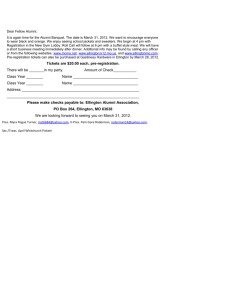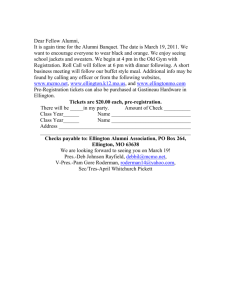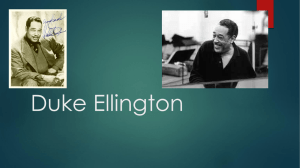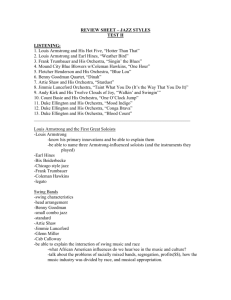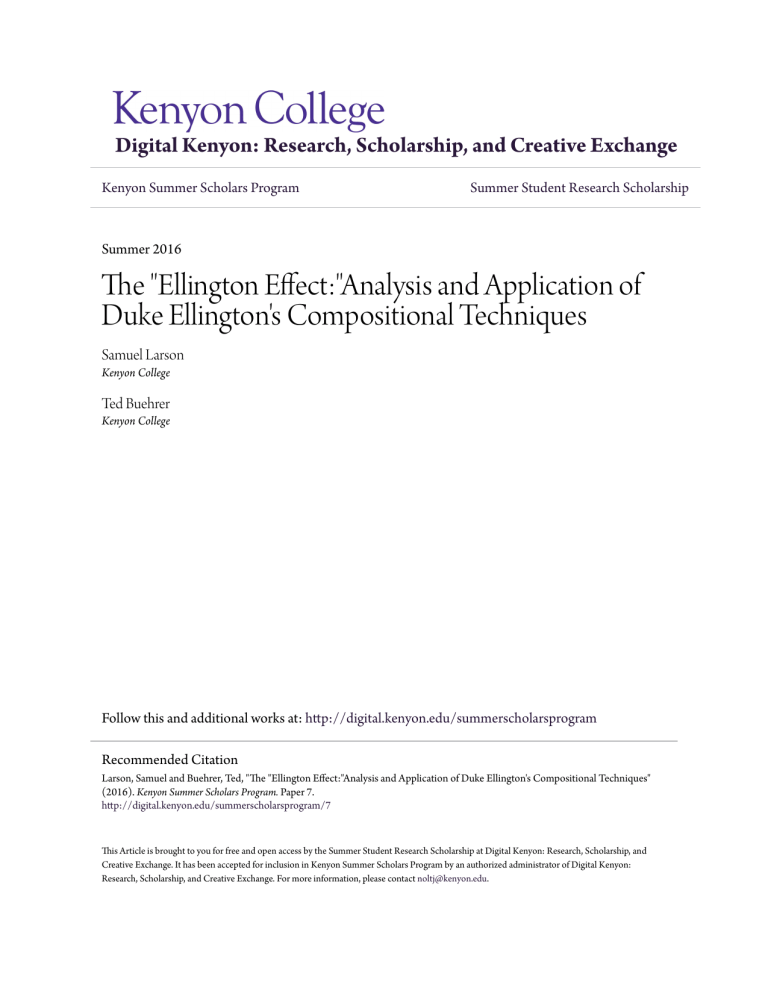
Digital Kenyon: Research, Scholarship, and Creative Exchange Kenyon Summer Scholars Program Summer Student Research Scholarship Summer 2016 The "Ellington Effect:"Analysis and Application of Duke Ellington's Compositional Techniques Samuel Larson Kenyon College Ted Buehrer Kenyon College Follow this and additional works at: http://digital.kenyon.edu/summerscholarsprogram Recommended Citation Larson, Samuel and Buehrer, Ted, "The "Ellington Effect:"Analysis and Application of Duke Ellington's Compositional Techniques" (2016). Kenyon Summer Scholars Program. Paper 7. http://digital.kenyon.edu/summerscholarsprogram/7 This Article is brought to you for free and open access by the Summer Student Research Scholarship at Digital Kenyon: Research, Scholarship, and Creative Exchange. It has been accepted for inclusion in Kenyon Summer Scholars Program by an authorized administrator of Digital Kenyon: Research, Scholarship, and Creative Exchange. For more information, please contact noltj@kenyon.edu. The “Ellington Effect:” Analysis and Application of Duke Ellington’s Compositional Techniques Samuel Larson ‘17 and Ted Buehrer Ph.D. Kenyon Summer Scholars 2016 Abstract Application of Sophisticated Lady This project focused on the composition of thirteen original jazz songs. These songs—three blues compositions, five ballads, and five swing compositions—were composed based on analysis of selected works by Duke Ellington and Billy Strayhorn. In particular, this analysis focused on vital elements such as harmony, melody, motivic usage and transformation, and song unity. These original compositions have been recorded with the help of Seth Reichert, featuring Jeremy Stern on piano and Max Lazarus on alto saxophone, and will be available for reference. Duke Ellington is widely to considered to be one of the finest composers of the 20th century; his work—and that of his partner Billy Strayhorn—is widely admired by jazz listeners, academics, and average music fans alike. This project sought to pinpoint elements of “The Ellington Effect,” the unique, individual sound Ellington achieved in his compositions. While this project was limited in its scope—looking only at composition and not arrangement—it nonetheless spent significant analysis on some of Ellington’s and Strayhorn’s finest works in the blues, ballad, and swing styles. Of particular interest in Ellington’s compositions is the mastery with which he uses and alters melodic motives and provides embellishments to harmonic progressions. Strayhorn, on the other hand, offers significantly more advanced and adventurous harmonic and melodic material. • Opens with a harmonically ambiguous V-I of C major, the V of the F major tonal area. • First two subphrases are slightly varied, with the third presenting the largest shift. • Uses a couple rooted MM7-Mm7-mm7 shifts. • Based around descending half step motive. Sophisticated Lady—Ellington • Opens with a harmonically ambiguous V-I of Bb minor (initial Gb is often harmonized with an F chord), the II of the Ab major tonal area. • Measure 2 utilizes a chromatically descending melody with a chromatically descending harmony. The harmony is essentially an embellishment of Eb7, the dominant. • The first two subphrases are slightly modified versions of the same idea, with the third presenting the most change. • Ellington an iterations of MM7-Mm7, based on the same root (with other possibilities for such in the bridge). • The bridge presents a simple harmonic progression with a complex melody, the polar opposite of the A section. • The melody is highly syncopated and uses color tones liberally. • While seemingly unrelated, the two sections are unified through a single motivic idea: a descending half step. Chelsea Bridge—Strayhorn • Van Echten, Carl. [Portrait of Billy Strayhorn.] Photograph. 1958. Library of Congress, Washington D.C. • Establishes harmonic ambiguity (alternating between II and I) after an upwards melodic sweep to begin the tune. • Tonal area established when Strayhorn used a VI-II-V-I. • Strayhorn’s first two measures are condensed into the third, using diminution. • Strayhorn juxtaposes his upwards melodic sweep against a chromatically descending harmony in measure 8. • Strayhorn’s bridge tonicizes three different keys, and moves between them using a diminished chord built off of the mediant. • The bridge is highly active compared to the A section, both rhythmically and melodically. • Strayhorn uses a large amount of adventurous color tones in his melody. Application of Chelsea Bridge • Opens with a small upwards sweep and establishes tonal ambiguity, alternating between V and VI. • Establishes tonal center on a VI-II-V-I. • Initial motive used in retrograde in the second half of A. • Chromatically descending harmony in measure 8 juxtaposed with upwards melodic sweep. • The bridge tonicizes four key areas using diminished seventh chords based off of the mediant. • Bridge is much more active than A section. Cotton Tail—Ellington • Cotton Tail uses rhythm changes—a popular harmonic progression based on Gershwin’s I Got Rhythm. • As a swing tune, it uses syncopation liberally • Its first two phrases exclusively use notes from the pentatonic scale. • While the first two phrases have a relatively static contour, while the third has a definite downward slope. • The third phrase incorporates a more liberal use of color tones, particularly in an upwards, chromatic manner. • Ellington’s #11 in measure five is used to grab ahold of the listener’s attention, being the first non-pentatonic pitch, and the longest in duration. Application of Cotton Tail • • • • Hopskip uses rhythm changes. Syncopation is a driving factor in the tune. Its first three phrases exclusively use pentatonic tones. The final phrase makes extensive use of chromatic color tones in a definite downward contour. • The bridge of Hopeskip consists of four variations of a two-measure phrase, each based on a syncopated pattern of #9 tones. • Unknown. [Portrait of Duke Ellington.] Photograph. 1940s. • The Real Book, Sixth Edition. Hal Leonard, 2004. Print.
